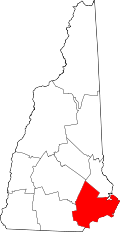History
Frost lived in the house from the fall of 1900 until it was sold in November 1911. [7] : 73 The majority of the poems collected in his first two books, A Boy's Will and North of Boston , were written here. [7] Many of the poems in his 1916 collection Mountain Interval were also written at the Derry farm. [8] Frost once said, "There was something about the experience at Derry which stayed in my mind, and was tapped for poetry in the years that came after." [9] During this period Frost also published a dozen articles for two agricultural trade journals: The Eastern Poultryman and The Farm-Poultry. [10]
Elliott, first son of Frost and his wife Elinor, died on the farm in 1900 at age four, likely due to influenza. [11] : 15 The other children were educated at home by their parents. Lesley Frost later recalled she was "taught the alphabet on a typewriter... My mother taught the organized subjects, reading (the phonetic method), writing (then known as penmanship), geography, spelling. My father took on botany and astronomy." [11] : 27
A hired man named Carl Burrell (and, occasionally, Burrell's father) assisted with farming duties like building hen coops, tending livestock, and picking apples and pears. [7] : 74 Locals thought Frost was lazy as a farmer. [11] : 15 He later recalled that they were correct: "I always liked to sit up all hours of the night planning some inarticulate crime, going out to work when the spirit moved me, something they shook their heads ominously at, with proper prejudice. They would talk among themselves about my lack of energy. I was a failure in their eyes from the start." [7] : 74
The family moved out in the fall of 1909 to rented lodgings in Derry Village while Frost taught at the Pinkerton Academy. They later moved to Plymouth, New Hampshire, so that Frost could teach at the Plymouth Normal School. [11] : 34
In the 1940s, after Frost had left the farm, the property took on use as a junk yard. The field behind the home was littered with hundreds of junk cars, and the home itself fell into disrepair. The property was obtained by the state of New Hampshire in 1964. By 1975, restorations were complete and the farm was opened for public visitation. [12]
Modern history
The property, originally owned by Frost's grandfather, was declared a National Historic Landmark in 1968. [4] [13] The property is a New Hampshire state park. [6]
It is located on the east side of Rockingham Road (New Hampshire Route 28), 2 miles (3 km) southeast of Derry Village. It is open to the public seasonally.
Visits to the information center in the barn and self-guided tours around the property are free. Guided tours are available for a fee.
Chair similar to the one that Frost used for writing; on the table lie copies of
The Youth's Companion which he read to his children and students.
Original soapstone sink with marks where the Frost family sharpened their knives. It was found in the cellar and reinstalled in the 1980s.
This page is based on this
Wikipedia article Text is available under the
CC BY-SA 4.0 license; additional terms may apply.
Images, videos and audio are available under their respective licenses.






